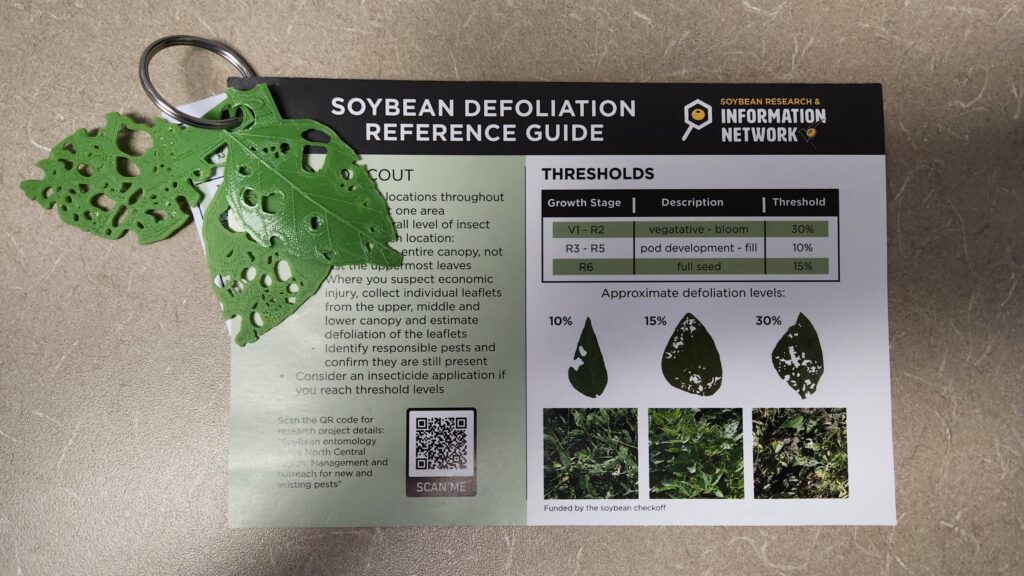Insect feeding is a yearly occurrence in soybean fields throughout Illinois. There are a variety of insects that feed on our soybean plants and in most cases, we do not pay attention unless it becomes visual at 60 mph. Generally, by the time you notice insect feeding, it is beyond the economic threshold of feeding. Scouting for insects is an important part of our crop management tools.
Defoliating is defined as premature removal of grass parts, usually leaves, by cutting or grazing. Insect defoliation can become devastating to a soybean crop if gone unnoticed. According to an article from Iowa State University Extension, Keep an Eye out for Soybean Defoliators by Terry Basol, defoliation in the vegetative stages can be heavier than defoliation during reproductive stages. The threshold for vegetative stages (V1-R2) is 30 percent defoliation, pod development (R3-R5) is 10 percent defoliation, and full seed (R6) is 15 percent defoliation.

Fig. 1. Different growth stages of a typical soybean plant, including vegetative (V) and reproductive (R) stages. Several vegetative and reproductive developmental milestones are indicated. Adapted from Neeser et al. (53), with permission.
Protecting the leaf surface is important because leaves are similar to “solar panels.” These solar panels convert light energy into chemical energy that the plants will use for growth, photosynthesis, sugar development, and plant cell growth. Each trifoliate is attached to the stem and node, and this is where flowers and pods develop. Research has shown a key factor that drives soybean yield loss from defoliation is the reduction of light interception in the canopy. As long as the remaining leaves can intercept at least 90 percent of the light, soybeans can still maintain 100 percent of their yield potential, according to Basol’s article.
So far, 2024 has been a low population year for defoliating insects in soybeans. In East Central Illinois, our main insect issue right now is japanese beetles. We skirted the beanleaf beetle population because of the later planting dates that occurred this year. Japanese beetles are heavy defoliators in soybeans as well as many types of trees, bushes and flowers. Japanese beetles feed on leaf tissue and leave the veins of the leaves, skeletonizing the leaf and leaving no surface to collect light energy.
Other defoliating insects we typically see in our soybean fields are beanleaf beetles, grasshoppers, wollybear caterpiller, green cloverworm, and loopers.
If you have multiple defoliating insects in a field, your threshold will be met sooner than if you have only a few insects.
To evaluate defoliation in your soybean canopy, you want to randomly collect three leaves from different points on the canopy from 10 different plants. Evaluate the defoliation of each leave and find an average. If you need help determining what each percentage is of each leaf, you can find several examples online from universities, as well as the Illinois Soybean Association has useful keychains and pamphlets for guidance available.

Soybean Defoliation Reference Guide from Soybean Research & Information Network (Submitted by S. Weckel)
If the canopy feeding has active insect and warrants a control measure, talk with your local retail representative and decide what would be the best control measure for your field. As soybeans approach the R2 (Full Flower) growth stage, this is an ideal time to apply a foliar fungicide, so you may be able to make the insecticide application for your foliar fungicide.
Although we do not think very much about insect feeding, insect management is a key part of maximizing soybean growth and yield. We want to protect this crop, and the “solar panels” all the way through the season. Ignoring any stage of soybean growth can affect our potential ending yield.
Sources:
Keep an Eye out for Soybean Defoliators, Terry Basol, Field Agronomist in NC Iowa
Functional Mapping of Developmental Processes: Theory, Applications, and Prospects – Scientific Figure on ResearchGate. Available from: https://www.researchgate.net/figure/Different-growth-stages-of-a-typical-soybean-plant-including-vegetative-V-and_fig1_224918256 [accessed 17 Jul 2024]


 and then
and then